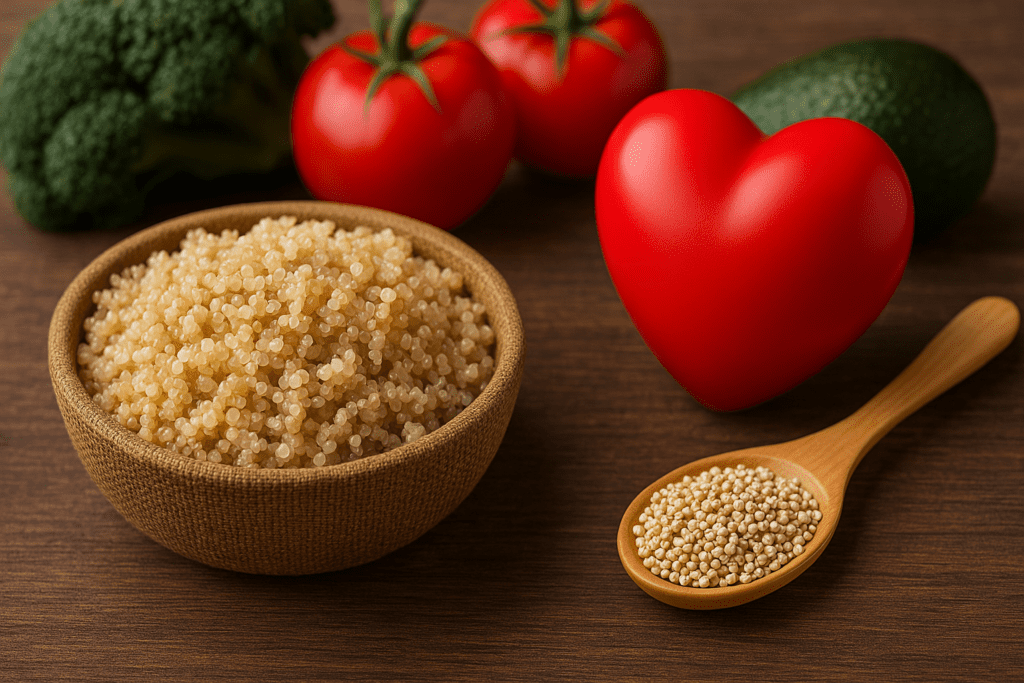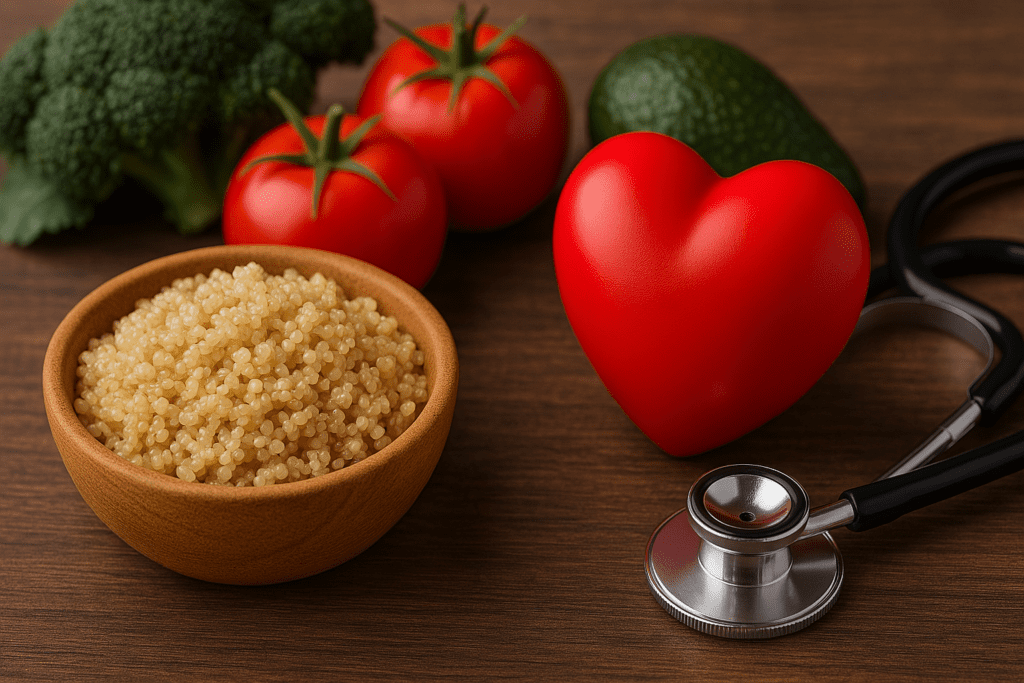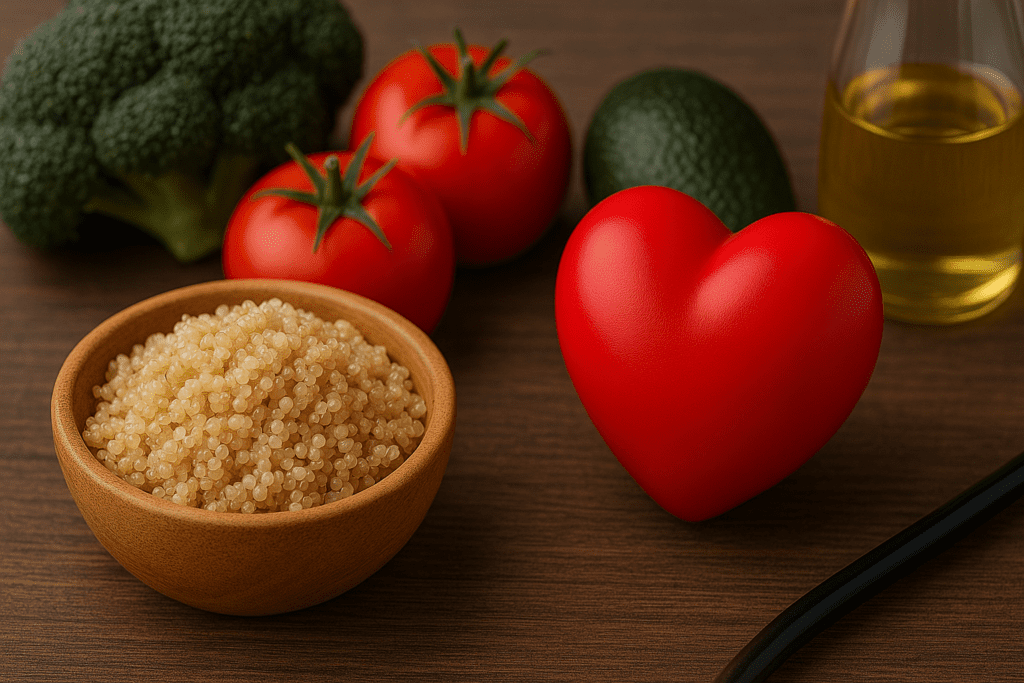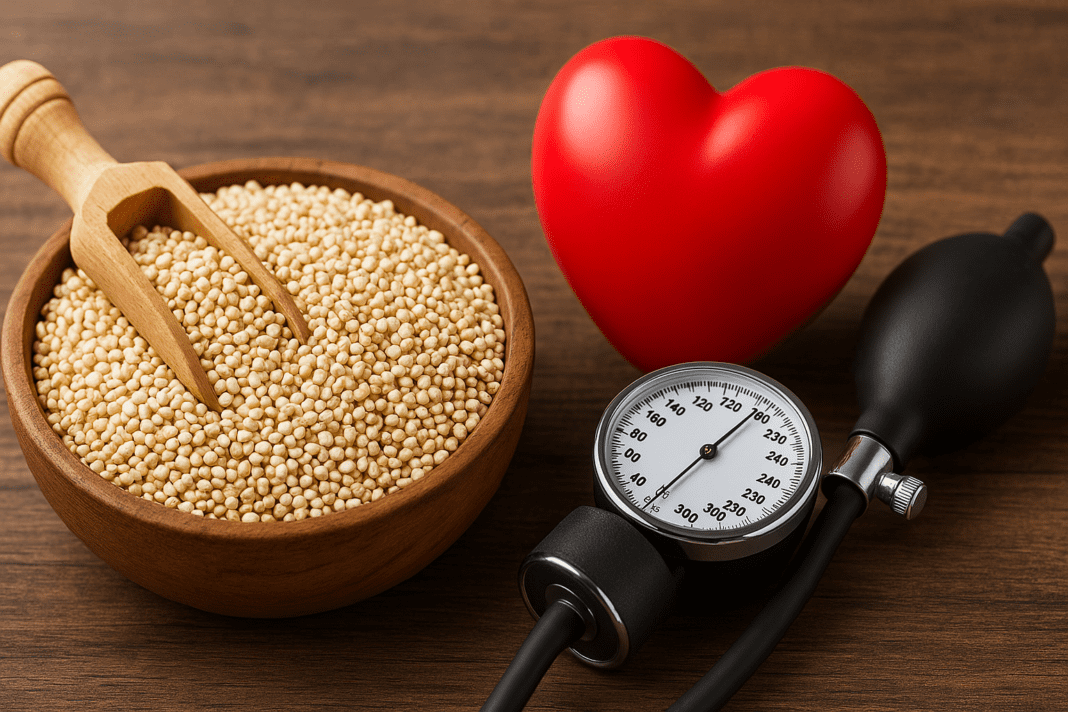Introduction: The Growing Search for Natural Solutions to Hypertension
In a time when millions of Americans are managing high blood pressure—also known as hypertension—the quest for natural, food-based solutions has never been more urgent or widespread. Cardiologists, nutritionists, and public health researchers are increasingly focused on the role of diet in cardiovascular health, exploring how specific foods may help regulate blood pressure and reduce long-term health risks. Among these, quinoa—a seed often referred to as a grain—has gained attention not just for its nutritional density, but also for its potential to support heart health. But is quinoa good for high blood pressure, or is this just another trendy food myth without strong scientific backing?
You may also like: Top 15 Foods to Avoid with High Blood Pressure: What Not to Eat When Managing Hypertension
This article takes a deep dive into the research, offering an expert-informed view on how quinoa interacts with blood pressure regulation, its nutritional composition, and how it fits within evidence-based dietary guidelines for hypertension. Whether you’re managing your own blood pressure or seeking credible resources for patients or loved ones, understanding the relationship between quinoa and cardiovascular wellness could offer an actionable, science-backed path to better health.
Understanding High Blood Pressure and Its Dietary Triggers
To grasp why quinoa for blood pressure is even a relevant topic, it’s important to understand how blood pressure works and why it becomes elevated in the first place. High blood pressure is a chronic condition where the force of blood pushing against the artery walls is consistently too high, often defined as readings above 130/80 mmHg. Over time, this persistent pressure damages blood vessels and vital organs, including the heart, brain, and kidneys.
Dietary factors are key contributors to hypertension. High sodium intake, low potassium levels, refined sugar, trans fats, and excessive alcohol consumption are well-documented culprits. Conversely, a diet rich in fiber, magnesium, potassium, antioxidants, and plant-based protein has been associated with lower blood pressure. This is where quinoa enters the discussion. While it is not a medication or cure, quinoa contains several nutritional components known to support vascular health and blood pressure regulation when consumed as part of a balanced, heart-conscious diet.
What Makes Quinoa a Unique Nutritional Powerhouse?
Quinoa (Chenopodium quinoa) is often categorized with whole grains, but it is technically a pseudocereal, meaning it functions nutritionally like a grain but comes from a different botanical group. It is native to the Andes and has been cultivated for thousands of years by indigenous communities for its hearty yield and health-promoting properties. Unlike many plant foods, quinoa is a complete protein source—it contains all nine essential amino acids the body cannot produce on its own. This makes it particularly valuable in plant-based or low-meat diets, where protein diversity can be a challenge.
In addition to its complete protein profile, quinoa is rich in fiber, magnesium, potassium, and iron—all nutrients with well-documented cardiovascular benefits. One cup of cooked quinoa provides around 8 grams of protein, 5 grams of fiber, and 30% of the recommended daily intake for magnesium. Since magnesium plays a vital role in vascular tone and endothelial function, consuming magnesium-rich foods like quinoa may have a direct influence on blood pressure control. But the question remains: is quinoa good for high blood pressure when evaluated through the lens of clinical evidence?

Quinoa and Blood Pressure: What the Research Shows
Emerging research suggests that quinoa may indeed have positive effects on blood pressure, primarily due to its fiber, magnesium, and antioxidant content. Several animal and human studies have explored quinoa’s physiological effects on cardiovascular markers, including blood pressure.
In a 2017 study published in Plant Foods for Human Nutrition, rats with high-fructose-induced hypertension were fed quinoa-enriched diets. Results showed improved lipid profiles and modest reductions in blood pressure compared to control groups. Though animal studies cannot be directly extrapolated to humans, they offer early biological plausibility. Additionally, a small clinical trial in 2018 investigated the effects of daily quinoa consumption in overweight adults and found improvements in metabolic markers, including reduced systolic blood pressure and enhanced satiety.
While large-scale randomized controlled trials specifically examining quinoa for blood pressure management are still limited, quinoa’s nutritional profile aligns closely with elements of the DASH (Dietary Approaches to Stop Hypertension) diet. The DASH diet is one of the most widely endorsed eating patterns for managing high blood pressure and emphasizes whole grains, potassium-rich foods, lean proteins, and fiber—all categories in which quinoa excels. Thus, while we may not yet have quinoa-specific hypertension guidelines, the evidence supporting its inclusion in a heart-healthy diet continues to build.
The Role of Magnesium in Blood Pressure Regulation
One of the most compelling connections between quinoa and blood pressure comes down to its magnesium content. Magnesium is a cofactor in over 300 enzymatic reactions in the body and is essential for muscle relaxation, including the smooth muscles in the walls of blood vessels. When magnesium levels are sufficient, these muscles relax more effectively, resulting in decreased vascular resistance and lower blood pressure.
Studies have consistently linked low magnesium levels to increased blood pressure, while magnesium supplementation has been shown to produce modest but statistically significant reductions in both systolic and diastolic pressure. One meta-analysis published in the American Journal of Clinical Nutrition found that magnesium supplementation was associated with a 2 mmHg decrease in systolic and a 1.78 mmHg drop in diastolic blood pressure.
Given that a single cup of quinoa delivers approximately 30% of the daily recommended magnesium intake, regular consumption could help individuals meet this requirement through food alone. While quinoa for blood pressure is not a substitute for antihypertensive medications, it may serve as a valuable dietary component in a comprehensive management plan.
Quinoa’s High Fiber Content and Vascular Health
Another important factor to consider is fiber, specifically soluble fiber, which can help improve blood lipid profiles and reduce arterial stiffness. Fiber-rich diets are associated with lower blood pressure, reduced LDL cholesterol, and improved endothelial function, all of which play roles in the development and progression of hypertension.
Quinoa contains both soluble and insoluble fiber, with a favorable ratio for cardiovascular health. Unlike refined grains that lose most of their fiber during processing, quinoa retains its natural fibrous structure, contributing to slower digestion, more stable blood sugar levels, and reduced strain on the vascular system. In the context of managing high blood pressure, these effects translate to improved arterial elasticity and less risk of pressure-induced damage to the cardiovascular system.
Moreover, diets high in fiber tend to promote weight loss and improved insulin sensitivity, both of which are intimately linked to better blood pressure outcomes. Excess weight and insulin resistance are known contributors to hypertension. Incorporating fiber-dense foods like quinoa may help break this cycle, allowing patients to address multiple risk factors simultaneously.
The Potassium Advantage: Balancing Sodium for Cardiovascular Benefit
One of the lesser-known but critically important benefits of quinoa is its high potassium content. Potassium is a counterbalance to sodium in the body and plays a central role in blood pressure regulation by facilitating the excretion of sodium through urine and helping relax blood vessel walls. Low potassium intake, especially in the context of high sodium consumption, is associated with increased blood pressure and a higher risk of cardiovascular events.
A single cup of cooked quinoa contains roughly 320 mg of potassium. While this is not as high as potassium levels found in bananas or sweet potatoes, it is significant when consumed regularly and in conjunction with other potassium-rich foods. The cumulative effect of potassium-rich dietary patterns can significantly impact blood pressure over time.
Given the prevalence of high-sodium processed foods in modern diets, adding potassium sources like quinoa for blood pressure management may provide a critical dietary correction. For patients unable to tolerate potassium supplements due to kidney concerns, food-based potassium sources may offer a safer and more sustainable alternative.
Antioxidants and Inflammation: Quinoa’s Protective Polyphenols
Chronic inflammation and oxidative stress are key contributors to vascular damage and the development of hypertension. Quinoa is a rich source of antioxidant compounds, including quercetin, kaempferol, and various polyphenols, which help neutralize free radicals and support endothelial health.
Quercetin, in particular, has shown promise in reducing blood pressure in animal and human studies by modulating nitric oxide levels and improving endothelial function. These antioxidant effects may be especially relevant in hypertensive individuals with coexisting metabolic syndrome, diabetes, or chronic inflammation, where vascular damage is more pronounced.
Importantly, quinoa’s antioxidants are preserved best when the grain is minimally processed and cooked gently, such as by steaming or simmering rather than frying. This makes it not only a nutritional powerhouse but also a flexible and adaptable food choice that integrates well into various heart-healthy cooking methods.
Comparing Quinoa to Other Heart-Healthy Grains
While quinoa stands out for its complete protein profile, it’s worth comparing it to other commonly recommended grains like oats, brown rice, and barley, which also offer cardiovascular benefits. What sets quinoa apart is its combination of high-quality plant protein, fiber, magnesium, potassium, and antioxidants all in one package.
Oats are rich in beta-glucans, which are excellent for cholesterol management but lower in protein and magnesium compared to quinoa. Brown rice is a familiar staple but lacks the complete protein and antioxidant density that quinoa provides. Barley is another strong contender for cardiovascular health, but it tends to be less versatile in flavor and takes longer to prepare.
For individuals specifically interested in quinoa for blood pressure management, the grain offers a multi-faceted nutritional profile that complements other whole foods in a hypertension-friendly diet. It doesn’t need to replace these other grains but can enhance dietary diversity and nutrient density when rotated in as a staple.
How to Incorporate Quinoa Into a Blood Pressure-Friendly Diet
For those looking to incorporate quinoa into their diet with a focus on heart health, the good news is that it’s incredibly versatile. It can be used as a base for grain bowls, added to soups and salads, or even made into porridge for a fiber-rich breakfast. It pairs well with legumes, leafy greens, nuts, and healthy fats like olive oil—all of which are staples of the DASH and Mediterranean diets.
When preparing quinoa, it’s advisable to rinse it thoroughly before cooking to remove saponins—a natural coating that can impart a bitter taste. Cooking it in low-sodium vegetable broth rather than salted water can enhance flavor without adding excess sodium, which is a key consideration for blood pressure management.
Meal planning with quinoa for blood pressure control could include dishes such as quinoa and black bean bowls, quinoa tabbouleh with parsley and lemon, or warm quinoa porridge with cinnamon and sliced almonds. These preparations not only promote heart health but also add variety and enjoyment to meals, which supports long-term dietary adherence.

Considerations, Precautions, and Expert Recommendations
While quinoa is generally well-tolerated, individuals with food sensitivities or gastrointestinal disorders should introduce it gradually. Though rare, some people may experience bloating or mild digestive upset when first increasing fiber intake. Starting with smaller portions and gradually increasing can help the body adjust.
For patients on blood pressure medications, it’s also important to avoid assuming quinoa or any single food will replace medical treatment. Instead, it should be seen as part of a broader strategy that includes regular physical activity, stress management, medical supervision, and a comprehensive dietary plan. Healthcare providers can guide patients in customizing their nutrition to align with medication regimens and personal health needs.
From a clinical perspective, experts increasingly recommend integrating whole foods like quinoa into routine care for cardiovascular risk reduction. Organizations such as the American Heart Association endorse plant-based eating patterns, and quinoa aligns closely with these principles.
Frequently Asked Questions: Quinoa and Blood Pressure
1. Can quinoa help reduce salt sensitivity in people with hypertension?
Yes, quinoa may offer benefits for individuals with salt-sensitive hypertension, which is a common but often overlooked subtype of high blood pressure. Salt sensitivity can lead to exaggerated blood pressure responses after consuming sodium, and managing it often involves increasing potassium, magnesium, and fiber—nutrients that quinoa provides in abundance. While quinoa for blood pressure is not a treatment in itself, it supports a nutrient profile that can help regulate sodium excretion and vascular tone. Moreover, emerging research suggests that plant-based diets high in magnesium and potassium may specifically benefit salt-sensitive individuals. For those wondering is quinoa good for high blood pressure in salt-sensitive cases, the answer is promising, particularly when quinoa is paired with other low-sodium dietary strategies.
2. How does quinoa compare to sodium-lowering medications in managing blood pressure?
Quinoa is not a substitute for medications like ACE inhibitors or diuretics, but it plays a supportive role in enhancing dietary approaches to hypertension. While pharmaceuticals target blood pressure through biochemical pathways, quinoa influences underlying dietary risk factors like sodium retention, inflammation, and insulin resistance. Several clinical nutritionists now recommend using quinoa for blood pressure control as part of a food-first strategy, particularly for patients interested in reducing medication dependency over time. That said, quinoa should complement—not replace—pharmacological interventions, especially in moderate to severe cases. For those asking is quinoa good for high blood pressure as a standalone fix, it’s more accurate to say it’s part of a broader, integrative solution.
3. Are there cultural or regional cuisines that use quinoa in heart-healthy ways?
Yes, many Latin American and Mediterranean-inspired dishes incorporate quinoa in ways that align with cardiovascular health guidelines. For example, Peruvian stews often feature quinoa paired with garlic, herbs, and legumes—ingredients known for their heart benefits. Similarly, in modern Mediterranean fusion cooking, quinoa is increasingly used in place of white rice or pasta, allowing for enhanced fiber and mineral content. These recipes naturally reduce processed sodium while maximizing plant-based protein and whole grains. Using quinoa for blood pressure in culturally relevant ways may improve dietary adherence, especially for patients hesitant to try unfamiliar health foods. This versatility makes the answer to is quinoa good for high blood pressure a global “yes,” as it adapts well to a variety of traditional cooking styles.
4. What are some creative ways to use quinoa in a low-sodium meal plan?
Incorporating quinoa into a low-sodium meal plan doesn’t require bland or repetitive meals. Try using quinoa as a base for a roasted vegetable bowl topped with lemon juice, tahini, and a dash of turmeric. You can also create stuffed bell peppers with quinoa, black beans, and spinach—adding cumin and fresh cilantro for flavor without relying on salt. Cold quinoa salads with cucumbers, olive oil, and vinegar make for refreshing, heart-healthy lunches. These creative applications make it easier to stick to dietary guidelines, especially when using quinoa for blood pressure support over the long term. So, if you’re still wondering is quinoa good for high blood pressure, its adaptability in flavorful, salt-free recipes is a clear advantage.
5. Does the method of cooking quinoa affect its blood pressure benefits?
Yes, how you cook quinoa can subtly influence its cardiovascular effects. Overboiling may cause mineral leaching, particularly potassium and magnesium, which are critical for regulating blood pressure. Steaming or simmering quinoa in unsalted broth helps preserve its nutritional integrity. Additionally, avoid frying quinoa or combining it with high-sodium sauces, as this can negate its heart-health advantages. To fully harness the potential of quinoa for blood pressure, cooking methods should prioritize nutrient preservation and minimal sodium use. So, when considering is quinoa good for high blood pressure, remember that preparation style can either enhance or compromise its benefits.
6. Can quinoa be safely included in hypertension diets for people with kidney issues?
Caution is warranted here. While quinoa is beneficial for many people with high blood pressure, those with chronic kidney disease (CKD) must manage their potassium and phosphorus intake carefully. Quinoa is moderately high in both minerals, so portion control is essential for this population. That said, with proper medical supervision, small amounts of quinoa can often be safely included in renal diets—particularly in early-stage kidney disease or controlled hypertension. Using quinoa for blood pressure in CKD patients should always involve a registered dietitian familiar with renal nutrition. In such cases, answering is quinoa good for high blood pressure requires nuance and individualized care planning.
7. How does quinoa support long-term cardiovascular resilience beyond lowering blood pressure?
Quinoa’s influence extends well beyond blood pressure regulation. Its high fiber content supports cholesterol balance, while antioxidants like quercetin reduce endothelial inflammation. These mechanisms help prevent atherosclerosis and lower long-term risk for stroke and heart failure. In addition, quinoa’s low glycemic index helps stabilize blood sugar, indirectly supporting vascular health by reducing glycation-related damage. This makes quinoa for blood pressure part of a broader longevity strategy, not just a temporary dietary fix. So if you’re thinking is quinoa good for high blood pressure—also consider how it builds systemic cardiovascular strength over time.
8. Are there specific populations that may benefit more from quinoa for blood pressure?
Yes, certain groups may experience amplified benefits from quinoa-based dietary strategies. Postmenopausal women, for example, often face rising blood pressure linked to hormonal changes, and quinoa provides phytoestrogens and magnesium that may ease this transition. Individuals with metabolic syndrome—characterized by obesity, insulin resistance, and elevated blood pressure—can benefit from quinoa’s low glycemic index and high protein content. Athletes or physically active individuals with hypertension may also appreciate quinoa for its endurance-enhancing nutrients like iron and B vitamins. Therefore, for diverse populations managing hypertension, the answer to is quinoa good for high blood pressure is not only affirmative but also uniquely tailored to their physiological needs.
9. What emerging research is being done on quinoa and cardiovascular health?
Current studies are beginning to explore the role of quinoa-derived peptides—protein fragments released during digestion—in vascular function. These peptides may act similarly to ACE inhibitors, which are a class of blood pressure medications, by preventing the constriction of blood vessels. Researchers are also investigating the microbiome-related effects of quinoa’s soluble fiber, which may produce short-chain fatty acids linked to blood pressure regulation. Future clinical trials may determine whether quinoa for blood pressure should be included in targeted dietary prescriptions. So if you’re still asking is quinoa good for high blood pressure, keep an eye on the research pipeline—its potential is just beginning to unfold.
10. How can quinoa consumption improve adherence to heart-healthy eating habits?
One of the most underrated aspects of quinoa is its role in behavioral nutrition. Because it’s easy to prepare, quick to cook, and palatable for most people, quinoa increases the likelihood that patients will stick to their dietary goals. Convenience and satisfaction are critical for sustaining long-term change, especially in hypertension management, where success often hinges on consistency. Quinoa’s ability to serve as both a comfort food and a health food bridges a crucial gap in cardiovascular nutrition. By making heart-healthy meals more accessible and enjoyable, quinoa for blood pressure becomes more than just a health choice—it becomes a sustainable lifestyle component. When patients find food they enjoy, the question is quinoa good for high blood pressure becomes part of a much larger conversation about dietary empowerment and long-term adherence.

Conclusion: Why Quinoa Deserves a Place in a Heart-Healthy Lifestyle
So, is quinoa good for high blood pressure? The answer, based on current research and expert consensus, is a resounding yes—when included as part of a balanced, nutrient-dense diet. Quinoa offers an impressive combination of dietary fiber, complete plant-based protein, potassium, magnesium, and antioxidants, all of which contribute to blood pressure regulation and overall cardiovascular health.
While quinoa for blood pressure is not a stand-alone cure, it serves as a powerful example of how everyday foods can play a therapeutic role in managing chronic health conditions. For individuals living with hypertension or those seeking to prevent it, quinoa represents a versatile, scientifically supported, and delicious option that complements other evidence-based lifestyle interventions.
In the ongoing journey toward better heart health, incorporating quinoa into meals is more than just a culinary trend—it’s a meaningful step toward reducing risk, enhancing nutrient intake, and supporting the body’s natural systems of regulation and repair. As always, integrating any new food into your diet should be done mindfully and in consultation with a qualified healthcare provider, but the evidence in favor of quinoa continues to grow—both on your plate and in peer-reviewed science.
heart-healthy foods, DASH diet benefits, magnesium-rich grains, potassium and blood pressure, antioxidant foods for heart health, whole grains for hypertension, natural ways to lower blood pressure, fiber and cardiovascular health, quinoa nutrition profile, plant-based heart health, superfoods for hypertension, blood pressure diet plan, healthy grains alternatives, low-sodium diet tips, Mediterranean diet for heart health, functional foods and hypertension, anti-inflammatory foods for blood pressure, endothelial function and diet, hypertension-friendly meals, vascular health through nutrition
Further Reading:
Quinoa Health Benefits, and Tips to Prepare This ‘Superfood’
Disclaimer
The information contained in this article is provided for general informational purposes only and is not intended to serve as medical, legal, or professional advice. While MedNewsPedia strives to present accurate, up-to-date, and reliable content, no warranty or guarantee, expressed or implied, is made regarding the completeness, accuracy, or adequacy of the information provided. Readers are strongly advised to seek the guidance of a qualified healthcare provider or other relevant professionals before acting on any information contained in this article. MedNewsPedia, its authors, editors, and contributors expressly disclaim any liability for any damages, losses, or consequences arising directly or indirectly from the use, interpretation, or reliance on any information presented herein. The views and opinions expressed in this article are those of the author(s) and do not necessarily reflect the official policies or positions of MedNewsPedia.


